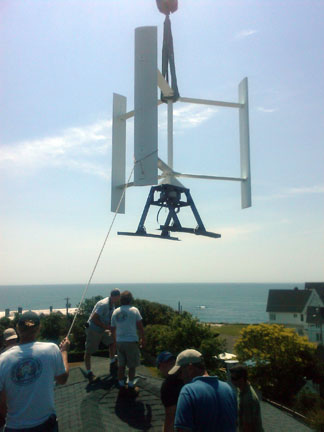The idea of harnessing wind energy conjures up, in many people’s minds, visions of sweeping West Texas plains filled with massive windmills perpetually spinning their 150-foot blades. But those monoliths have smaller cousins that are blowing into backyards across the country – including at least a few in Fort Worth – as the sustainable energy movement gains momentum.
Ranging in size and power, these wind turbines can provide up to 90 percent of the power needed by an average home, although in practice, consumer-level wind turbines are more suited to commercial than residential areas. The city has approved a handful of permit requests for wind turbines, but it’s not yet the easiest way to go green in Fort Worth.
Just ask Jan Underwood.
About a year ago, Underwood made plans to install a wind turbine for the new location of her school uniforms business south of I-30 near Horne Street. After consulting with her inspection company, Underwood learned that the turbine would exceed the height restrictions in the city’s zoning rules. She could appeal to the city for a variance that would allow her to overshoot the limit but was told the process would take months.
 Underwood’s project was already plagued by several months of delays and higher-than-expected costs. Leery of going forward on an expensive wind turbine that would involve more delays and might not get approved, she set aside the idea for now. So at 4555 Bryant Irvin Blvd., the business opened its doors this week using traditional power systems.
Underwood’s project was already plagued by several months of delays and higher-than-expected costs. Leery of going forward on an expensive wind turbine that would involve more delays and might not get approved, she set aside the idea for now. So at 4555 Bryant Irvin Blvd., the business opened its doors this week using traditional power systems.
“I had to put it on the back burner,” Underwood said. “I had a hard enough time getting telephone and electrical in here,” and time is running out. If she doesn’t get the turbine installed before Aug. 15, it won’t be included in her long-term financing for the building, she said.
Fort Worth has some of the strictest zoning rules in the state, said Glee Thomas, who led the inspection team for Underwood’s business and works for third-party inspection company Metrocode. Thomas also said, however, that strict zoning rules could ultimately be good for city residents interested in “going green” and that Fort Worth is still “a lot further ahead” than Dallas in adopting good regulations.
“There are a lot of people who are wanting to do it [use wind power] residentially, so I was excited about her [Underwood] doing it,” Thomas said. Consumer-level wind energy setups are possible here, she said, but it takes extra time, planning, and initial investment.
Wind turbines cost $20,000 or more and usually pay for themselves in energy savings in three or four years, according to turbine-seller WindTexas. Nationally, sales of consumer-level wind turbines almost doubled in the past year or two, and manufacturers are hoping to triple those numbers in the next five years, according to a recent report from the American Wind Energy Association (AWEA), a national trade association promoting growth in the wind industry.
Using wind turbines in urban areas is a tricky proposition, said Ron Stimmel, spokesman for the AWEA. “The rule of thumb is that the turbine should be 30 feet higher than any obstacle within a 500-foot radius,” he said. “Everybody likes to talk about rooftop turbines, but the physics doesn’t always line up.” His group’s report also noted that city zoning laws continue to be a problem for wind devices in many cities.
Wind energy owes much of its rapid growth to a federal investment credit for renewable energy that was expanded in the Obama administration’s February stimulus bill, Stimmel said.
Little of the growth has been in Texas, however, because the state provides few incentives, he said. “But we’re trying to change that. There’s a great deal of potential in Texas with the right policies.”
WindTexas, from which Underwood considered buying a wind turbine, is one of the companies trying to sell consumers on alternative energy sources. The Fort Worth firm was founded in 2008 to install and distribute consumer-level wind turbines. But with little government help available here and with no manufacturers located in Texas, the company is struggling. Company president Jonathan Kohn is working with his state representative on wind-industry incentives that might be considered when the Texas Legislature meets again in 2011.
Several bills that would have expanded incentives for “small-wind” and other renewable energy systems were proposed this year, but none passed before the legislature adjourned earlier this month.
“We are set back another year and a half,” said Russel Smith, executive director of the Texas Renewable Energy Industries Association, which represents businesses involved in wind, solar, biomass, and geothermal energies. He added that many companies had expressed interest in bringing renewable energy facilities to Texas, if incentives had been approved.
“A lot of that is simply not going to happen now,” he said. “We need policies in this state that will encourage renewable energy in all its forms. If we don’t do this, the state of Texas will miss out not only on the benefits of renewable power itself, but the industry that comes with it.”
Texas, of course, is plentifully supplied with wind. But the vast majority of Texas’ harnessed wind energy is controlled by utility companies and private investors. The state approved $5 billion last year for utility companies to bring wind power from West Texas to North Texas, especially the Dallas-Fort Worth area.
That move was “absolutely essential,” Smith said. But he added that most individuals will experience only a small amount of financial benefit from the measure. He said consumer-level incentives for wind energy need as much attention as large-scale projects: “When you combine those two, you can really begin to have significant impact.”
He said many Texans face the same problems as Underwood in changing to wind-powered energy systems. “Most cities and towns do not have any kind of measures about how to address wind turbines,” he said.
Underwood, 57, pursued many other methods of making her 4,980-square-foot building energy efficient and environmentally friendly. She installed efficient lighting and air conditioning, bought paper bags instead of plastic ones, installed concrete floors, and covered the walls with foam insulation.
Even though she’s set aside her wind-turbine plans for now, she’s still intrigued.
“I’m a fan of only needing six-mile-per-hour winds for power,” she said.











